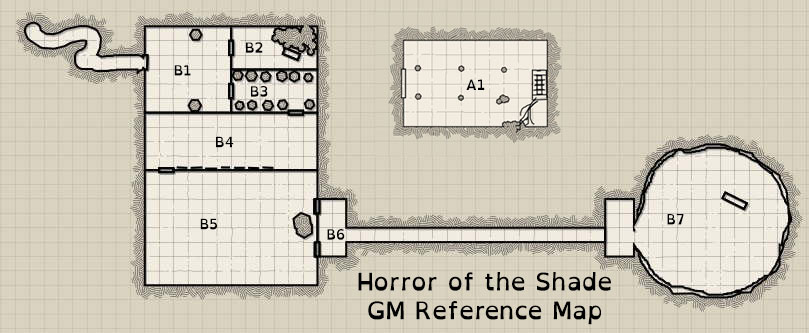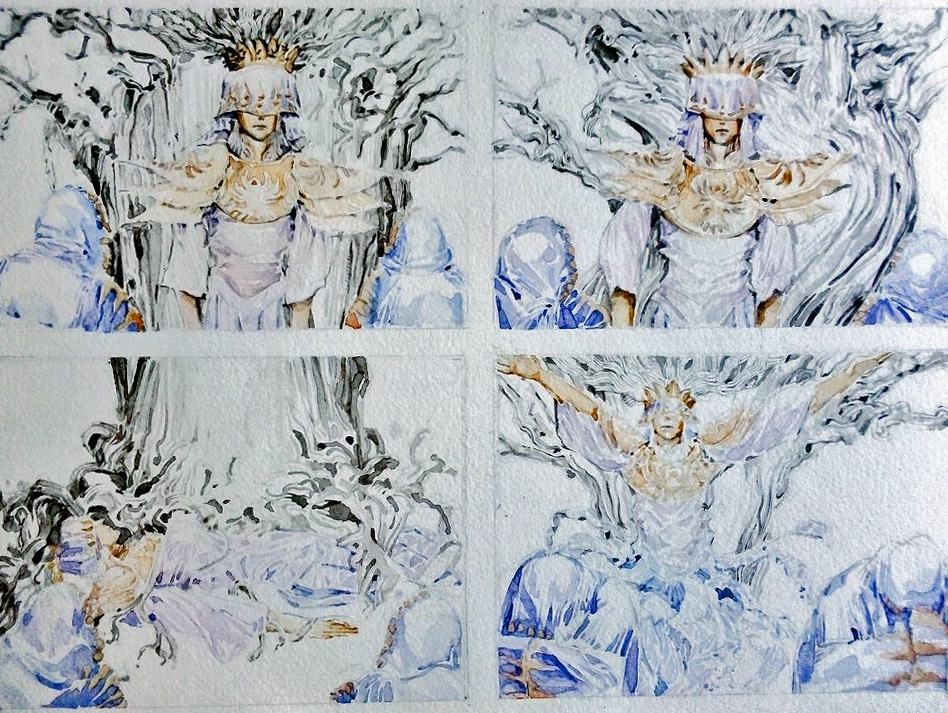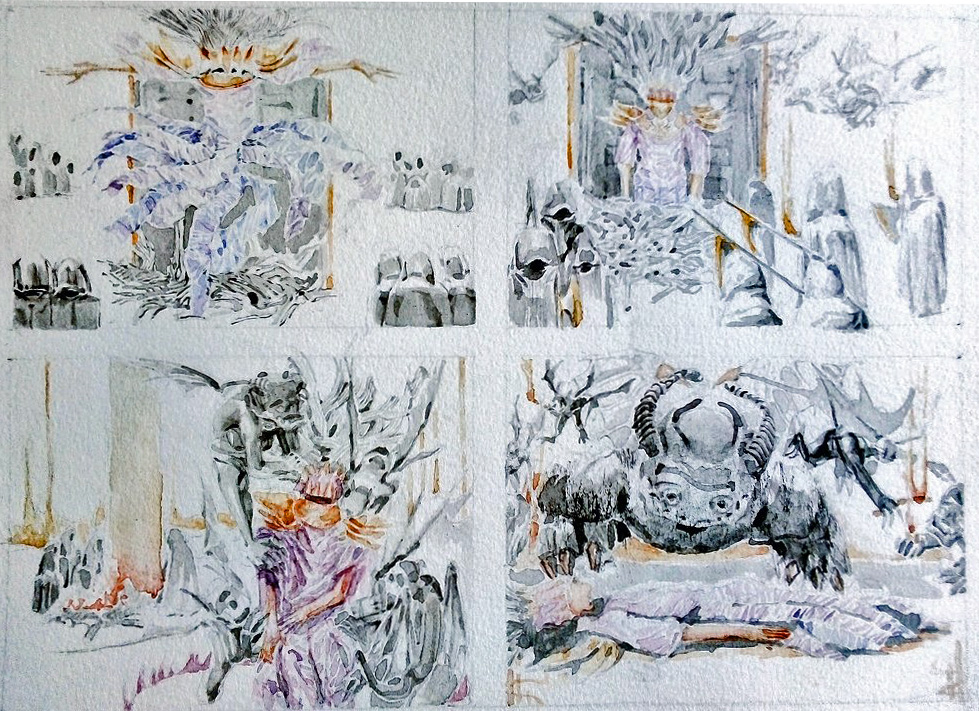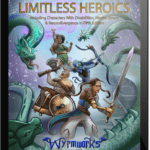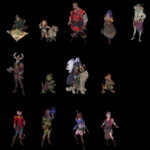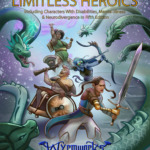Horror of the Shade
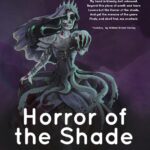
Horror of the Shade
Written by Theo Kogod
In the fell clutch of circumstance,
I have not winced nor cried aloud.
Under the bludgeonings of chance
My head is bloody, but unbowed.
Beyond this place of wrath and tears
Looms but the Horror of the shade,
And yet the menace of the years
Finds, and shall find, me unafraid.
-“Invictus,” by William Ernest Henley
Running the Adventure:
Players:
“Horror of the Shade” is a one-shot adventure designed for a party of 4–6 characters of levels 5 or 6.
Fellow Travelers:
As caravan guards, the player characters will meet others accompanying them on the road.
Kassios (He/Him): The charming caravan master is an impeccably dressed satyr with a waxed mustache who walks with a pronounced limp, using a well-polished cane (actually a cane-sword). He is partially deaf, uses a prosthetic bronze eye, and has a penchant for theatricality.
Ssauri’yanik (They/Them): This red dragonborn priest has dedicated their life to helping others. A skilled healer and herbalist, Ssauri’yanik uses their knowledge of plants and medicine to design specialized potions to heal injuries and help people manage their disabilities.
Tessaria (She/Her): A pragmatic gold dragonborn librarian transporting her book-hoard across the country, Tessaria possesses encyclopedic knowledge of history and myths. Her face and tone seldom reveal her emotions. She is sensitive to sound, and may verbally snap at others when she feels overwhelmed.
Background:
Millennia ago, the Naodh-Meer were a prehistoric matriarchy whose priestess-queens controlled trees and had transcended death. The Naodh-Meer were eventually conquered by the Anahksi, a patriarchal magocracy who torched the Naodh-Meers’ groves and built huge stone structures in their place.
Both the Naodh-Meer and Anahksi have long since vanished. All that remains are the stony ruins they built and the depleted remnants of their magic.
In the present, the characters serve as caravan guards who make camp amid Anahksi ruins, once built to imprison the undead Naodh-Meer witch-queen Wrot’idauth by entombing her in a demiplane. But the magics holding her have weakened. Gargoyles attack the caravan, and Wrot’idauth tries to escape during the fight. This triggers a magical defense which transports the ruins—and the caravan—into the prison dimension. To escape, the characters must either defeat the undead witch-queen, or else help her defeat the immortal stone guardians imprisoning her.
Introduction
The adventure begins as a caravan traveling through the hills prepares to make camp amid ancient ruins. The caravan master, a satyr named Kassios, has hired the characters as guards.
To begin, read the following text:
You were recently hired by the satyr Kassios to help guard his caravan, along with other travelers who paid for safe passage. Bandit raids and heavy rains have made the main road too treacherous for safe travel, forcing the wagon train into the hills to find a new route.
It has been a slow, bumpy ride across uneven ground choked with roots and hardscrabble. Cracked granite columns and crumbling stone blocks pock the otherwise empty slopes. The darkening sky breathes chill, moist air through the hills, portending a coming storm. As evening approaches, you search for somewhere to take shelter when suddenly Kassios shouts, “There! Just what we’re looking for!”
He points up the slopes with his cane. Amid toppled columns and broken masonry, a single building stands, its gable roof and marble walls seemingly still intact.
The caravan is composed of five wagons, each pulled by a pair of mules. There are roughly twenty passengers: mostly a mix of humans, dwarves, and halflings, plus two dragonborn. When the caravan stops, Kassios asks the player characters to ensure the ruins are safe and check in with the paying passengers while he attends to the animals.
Black roots grow over the structure and much of the surrounding rubble, but there are no trees in sight. Players scouting the structure and surrounding area find no enemies. For more info, see section A1: Ruins. (Horror of the Shade Map 1)
A successful DC 20 Intelligence (History) check reveals that the ruins were built by the lost civilization of the Anahksi. When examining the black roots, an unfamiliar, acrid odor is faintly detectable. A successful DC 10 Intelligence (Nature) check points out that there are no nearby trees and that the roots are pushing up through the soil. A successful DC 20 Intelligence (Nature) or Intelligence (Arcana) check shows that these are unlike any known tree root and may possess slight necromantic properties. Players looking through the rubble who succeed on a DC 15 Intelligence (Investigation) check will discover a toppled six-foot statue of a horned, fanged humanoid with wings.
As the caravan unloads, both dragonborn take longer than the other travelers.
One of them, a red dragonborn in priest’s robes named Ssauri’yanik, examines a patch of roots. They are a healer and herbalist who makes potions from plants, but have never seen anything like this.
The other, a gold dragonborn named Tessaria, is carrying a heavy chest, causing her to move slowly. If someone tries to assist her, she thanks them but refuses. Tessaria has a Sensory Processing Difference (IE 2) and is sensitive to continuous high- and low-pitched sounds. The grind of wagon wheels on their axles took a toll. Her chest contains rare books, a warm robe, and a tea set, which help ease her nerves.
A1: The Ruins
The ruins are an ancient Anahksi structure with walls, ceiling, and floor constructed from granite and marble blocks. General features:
Walls: The walls are 4 feet thick and sturdy but a section of the eastern wall has collapsed.
Ceiling: 20 feet high. A massive marble slab forms the ceiling. Two more slabs above it form a gable roof.
Columns: Two rows of marble columns run down the center of the room.
Entrances: The post-and-lintel entrance has no doors. The only other way in or out is the eastern wall’s gap.
Statue: A 10-foot-high statue depicts a seated man flanked by snarling horned beasts. Roots protrude from cracks under the statue, spreading across the floor toward the hole in the wall, creating difficult terrain in the northeast corner.
The ancient structure’s walls and floor are constructed of massive, smooth stone blocks. Strange glyphs mark the stone lintel above the entrance. Two rows of marble columns run down the length of it to the very back, where a statue depicts a man seated and flanked by wild beasts, their eroded features polished and cracked from age . Dark twisted roots have pushed up through cracks in the paved floor, growing toward a large hole in the eastern wall, from which a damp breeze wafts in.
The glyphs are from the lost Anahksi language. A successful DC 20 Intelligence (Arcana) check reveals similarities to the Primordial words “Tomb” and “Queen.” Characters fluent in Primordial or who consult Tessaria roll with advantage. The Comprehend Languages spell deciphers the full text:
“This Tomb Holds the Undead Forest Queen.”
Players who examine the statue notice that the man is seated on a petrified tree stump. A successful DC 10 Wisdom (Perception) check reveals that the wild beasts flanking him have small horns and folded stone wings.
Kassios follows the characters inside as it begins to rain. The satyr starts a fire near the hole in the back wall using firewood he brought with him. This downtime offers a chance to get to know the NPCs.
Kassios regales his passengers with stories around the fire.
Tessaria prepares some tea, reading a dense book by firelight that confirms her suspicion that the ruins are of Anahksi origin. If asked, she may reveal that the Anahksi who built this were an ancient empire who wielded elemental magic.
Ssauri’yanik cuts a clipping off one of the black roots to study as they mix herbs for potions. If a character has a noticeable injury or disability whose symptoms seems to be causing pain or discomfort (or if they volunteer such information), Ssauri’yanik may inform the character that they have a potion that could help manage symptoms.
As night descends, it begins to rain, and a loud roar echoes among the hills.
Kassios unsheathes his sword-cane and orders the players to take up their posts as guards. Outside, four winged gargoyles descend from the sky, growling loudly, their rough granite wings and arms grinding with every movement. Two approach the front door while two more attack the hole in the eastern wall. Sparse mosses and lichens dot their bodies, releasing a fetid earthy odor from being in the rain, and when a gargoyle is struck in combat, weapons and spells will occasionally impact the soft film of vegetation. They do not understand any modern language and cannot be reasoned with. They are guarding the ruins and intend to kill all trespassers.
Kassios fights with his sword-cane and has Stiffness (Legs and Feet) (IE 2). Tessaria or Ssauri’yanik might offer support through their breath weapons. Tessaria inserts earplugs at the start of combat. Ssauri’yanik has Hyperelasticity (IE 4) and Skeletal Flexibility (IE 3) and Dislocation (IE 3) and is cautious to avoid injury, but heals anyone who becomes seriously injured.
The other travelers try to flee to the back of the room to escape the monsters. Multiple travelers can squeeze together into a five-foot square, pressed close as they try to avoid the fray.
After the first gargoyle is killed, the two beasts flanking the statue at the back of the room begin to move, unfurling huge batlike wings and roaring loudly. These gargoyles are Small, and have 20 HP and 12 AC.
After a second gargoyle is killed, read the following:
As the gargoyle dies, you hear the bursting crack of ruptured stone from the back of the chamber. The statue explodes, dusting the room with splinters of shattered rock as a writhing tangle of black tree roots pushes up from below the floor. The remaining gargoyles react immediately, flying straight at the breach. They collide with a deafening crash and darkness flashes across your vision.
You recover a moment later to discover the gargoyles, tree roots, and broken statue have all vanished. In their place is a massive rent in the floor, the mouth of a passage. Outside the building, everything as far as you can see has been consumed by yellow glowing mists.
One Door Closes, Another Opens:
Any characters who were outside the building are instantly transported back inside.
The yellow mists outside shimmer and swirl, pressing against the building but not entering. From a distance, they smell faintly of burnt tin. The mists generate light for 30 feet and dim light for another 30. These are part of an ancient magical defense system created by the Anahksi to safeguard the structure and prevent the undead Naodh-Meer queen entombed below from escaping. It is impossible to see, hear, or scry anything through the mists, which cannot be dispelled. Teleportation spells such as Misty Step or Blink do not work normally within them. No one from outside can teleport in and no one inside can teleport out into the mists. If a character tries to teleport outside or travel to another plane, they feel a tingling pressure against their skin as their attempt fails. However, characters can teleport from one place to another within the main structure. This effect extends below the building into the passageway and rooms beyond, as characters can move about freely within any area on the map but cannot leave or enter a designated area using teleportation.
The rent in the floor is roughly 10×10 feet and opens to a passage that winds deep below the earth.
Everyone from the caravan is clearly shaken. Kassios tries to calm them, but the attack has ruined his good mood. He asks the players to explore the passage to neutralize any danger. If they resist, he offers to double their pay.
Either Tessaria or Ssauri’yanik can be persuaded to accompany the adventurers. The din of battle upset Tessaria, but she recognized the gargoyles as Anahksi Guardians, and is curious to learn more about the Anahksi ruins. Ssauri’yanik is interested in learning about the strange roots, and they want to provide medical support if the adventurers need it.
Anyone who tries leaving the building must succeed on a DC 16 Constitution saving throw when they enter the mists or when they begin their turn within them. On a failed save, they take 12 (2D8 + 3) psychic damage or half as much on a success.
A2: The Passage
The passageway is 10×10 feet and runs hundreds of feet deep underground, its dirt floors snaking back and forth with roots running along its walls and ceiling. The air is stale, humid, and permeated by a moldy odor. The first 50 feet are dimly lit before it becomes dark.
At the end, there is an open doorway where a massive stone slab has been pushed out and shattered on the passage floor. Beyond is a dimly lit room.
Examining the slab reveals it was once an intricately carved door with a complex locking mechanism that involved several sliding stone facets. At some point, roots pushed the door off its hinges. Beyond this door is a room glowing with dim, eerie yellow light.
Players will not discover this until later, but the tunnels originally connected the building above to a demiplane that the Anahksi created by drawing power from the Astral Plane and the Elemental Planes of Fire and Earth. They used it to imprison their greatest enemy, the Naodh-Meer witch-queen Wrot’idauth, locking her in a tomb with immortal stone guards. The roots breaking free during the fight above triggered a defense mechanism, pulling the tunnels and building into the demiplane.
The areas ahead have the following features:
Five-foot square stone blocks form the walls, floors, and ceilings.
Ceilings: 20 feet high. The ceiling is also 30 feet thick, eventually opening out into empty dimensional space.
Doors: Most doors are 8-foot-wide stone slabs that slide to one side along a groove in the floor.
Lighting: Darkness, except where yellow mists provide dim light.
Breathability: Every room allows for regular breathing. More than 30 feet beyond the outside of the structures in any direction, the pocket dimension does not allow for breathable air.
Anti-Teleportation: No one is capable of entering or exiting any room using teleportation. They also cannot travel to another plane. However, they can teleport from one area to another within a room.
Anti-Magic: The Hall of Murals, Guardian’s Chamber, and Bridge Across the Abyss all are protected by a faint Antimagic Field. This was created to prevent Queen Wrot’idauth from escaping, but has degraded over the millennia. Anyone casting a spell in the affected areas must succeed on a DC 10 roll using their spellcasting Ability + proficiency bonus or else the spell automatically fails.
B1: Trapped Chamber
Just inside the doorway lie the gargoyles who flew into the tunnel, smashed to rubble by the roots.
The smashed doorway opens into a wide room, dimly lit by a flitting yellow glow coming from a crack in the ceiling from which cool sterile air breathes into the chamber.
Strewn across the entryway lie scattered chunks of broken masonry, among which are the gargoyles’ recognizable horned faces and wing fragments.
Dim yellow light filters in through a crack in the ceiling. Anyone looking up notices something shocking: despite the party traveling deep underground, the crack passes through just 30 feet of rock, beyond which they can see the starry night sky illuminated by much-closer clouds of the glowing yellow gas. The crack also allows fresh air into the room.
The roots that run from the eastern door to the western one pushed both doors off their hinges, completely shattering the latter. A successful DC 10 Intelligence (Nature) check confirms that it is unusual for roots to not grow on the floor; DC 15, that they pushed down the westernmost door; DC 20 reveals wood fragments amid the broken gargoyles.
Two gargoyle guards used to sit on the plinths, which would sink six inches into the floor under the creatures’ weight. The gargoyles departed, causing the plinths to rise up and thereby priming the trap. If there is any weight on the floor for more than a minute, all of the floor tiles lining the eastern and western walls superheat, glowing red hot and causing the air above them to ripple with the scent of burnt ozone. Anyone who steps on these heated tiles or begins a turn on them must succeed on a DC 13 Constitution saving throw, taking 3D6 fire damage on a failed save or half of that on a success. After another minute, the next innermost rows of tiles heat up. After 3 minutes, the middle tiles heat.
A successful DC 12 Intelligence (Investigation) check reveals that the plinths can sink down six inches into the floor and reveal scrape marks left by the gargoyles’ claws. Applying 40 pounds of pressure to both plinths at once causes them to sink down, disabling the trap. Alternatively, piling the rubble onto the hot floor tiles allows someone to cross over them unharmed.
The northern unbroken door can be accessed with a successful DC 20 Strength (Athletics) check, forcing the heavy stone door off its hinges. Alternatively, a successful DC 15 Dexterity (Sleight of Hand) check can slide it open to one side along a hinge in the floor, while a successful DC 15 Intelligence (History) or Intelligence (Investigation) check will uncover a simple mechanism in the floor, triggering the door to slide open along its hinge, leading to the Mason’s Room. The already-open door leads to the Gargoyles’ Vigil.
B2: Mason’s Room
The door grinds to one side and dry stale air wafts out. Chalky dust coats the floors and a rubble heap is piled high in the northeast corner, beside which lies a stone slab.
This room was used by Anahksi masons building the tomb, who discarded broken masonry in the rubble pile. Several tools lie on a level stone slab that once served as a work table, caked with dust. These can be discovered with a successful DC 12 Intelligence (Investigation) check.
These crystalline tools are completely unrecognizable, except for one, the Hammerspike, with a double-sided head formed from solid silvery crystal which resembles both a pickaxe and a hammer.
This tool counts as both a warhammer or war pick and can be used by a character proficient in either. A player can decide whether to deal 1d8 bludgeoning or piercing damage when attacking with it. The Hammerspike is versatile, increasing the damage to 1d10 when wielded two-handed. It deals an additional 1d6 fire damage against Undead and Plants.
B3: Gargoyles’ Vigil
Two rows of gargoyles once stood here, but now the room is overgrown with dark roots which have smashed and smothered the bodies of the stone wardens.
This narrow room is completely choked and overgrown with a twisted knotwork of roots and black-leafed branches, growing out from an open door in the southeast corner. The gnarled pungent vegetation is so thick that you almost fail to see the hunched stone figures completely ensnared within tangles of wood.
Neither the roots nor the gargoyles pose any harm to the characters. A successful DC 10 Wisdom (Perception) check reveals that the gargoyles have been smashed by the roots and pose no threat. Some of them are held upright by branches and vines, and if they are distur bed, pieces of broken masonry will fall to the floor.
Anyone passing through the corridor must either make 3 successful DC 14 Strength (Athletics) or Dexterity (Acrobatics) checks or else become restrained by entanglement in the roots. Breaking free of these restraints causes the wood to snap loudly, releasing a shower of dry leaves. The roots can be destroyed with fire or weapons. They have AC 15, 200 HP, and take 30 minutes to be burned through. Inhaling the smoke chokes a person with its caustic bitter stench and causes 7 (3d4) poison damage.
If Ssauri’yanik is with the party, they will note that the leaves look especially flammable. The dragonborn will also observe that the tree roots must have moved at an alarming speed to break the gargoyles in this way. If Tessaria is present, she is eager to learn what is in the next room at the far end of the hall. In either case, the NPC should urge players forward.
B4: Hall of Murals
As you enter this room, an excited frisson tingles across your skin. Eight brightly painted bas-reliefs run along the southern wall of this beautifully stunning hall. The statuesque murals were masterfully carved with lifelike detail, and seem to tell some kind of story.
More of the familiar black roots have burrowed into the room through holes in the ceiling and floor, but these seem much thinner than the others, growing feebly toward the direction of the hallway you just left. Another sealed door is in the southwest corner.
This is the first of three rooms affected by the depleted Antimagic Field, but over the centuries, the field has weakened significantly (see the Anti-Magic Field section listed before entering B1). If Ssauri’yanik is with the party, they will recognize that the roots look sickly (a result of the Antimagic Field stifling them).
The bas-reliefs are three-dimensional and brightly colored with high contrast, so a person with limited vision should have an easier time seeing them if the room is lit.
They tell the story of the ancient Naodh-Meer queen, Wrot’idauth, who used tree magic to return from the underworld, and how she was eventually imprisoned in this tomb by the Anahksi. In order, the bas-reliefs depict the following, which you can read aloud from the next two pages.
If Tessaria is present, she can explain the history of this story, identifying the woman as the Naodh-Meer Queen Wrot’idauth, who was worshiped as a goddess and magically controlled trees. She was buried in a sacred grove, but resurrected herself. She dominated her former worshippers before trying to conquer the neighboring Anahksi. In response, the Anahksi burned the Naodh-Meer groves and used gargoyles to bury her in this tomb.
The door is shut but not locked. A successful DC 20 Strength (Athletics) or DC 15 Dexterity (Sleight of Hand) check causes it to slide to one side along a groove. Holding fire to the door opens it automatically. Anyone studying the paintings for clues can discern that the Anahksi used fire in their magic so fire might help open the door.
M1.
A woman stands, painted gold, crowned with a wreath of black tree branches. Before her, other gold-painted people kneel. A massive black tree towers over the woman, its branches and roots outstretched.
M2.
This bas-relief is similar to the previous one, but the woman has been painted the same black as the tree, whose trunk now bends low toward her, emulating a bow.
M3.
The woman no longer stands, but lies horizontally beneath the tree, the roots wrapping around her to form a coffin. The gold-painted people still bow, but now the tree stands straighter than ever, its branches pointing up toward the sky.
M4.
The woman rises up through the center of the tree, bursting out the top, her arms outstretched. The gold people who bowed in earlier panels turn away, cowering.
M5.
Hovering above a forest of gnarled black trees, the woman holds her arms outstretched, claw-like hands reaching toward a different group of humans on a distant hill. This new group is painted a shade of gray almost indistinguishable from the stone on which the relief was carved.
M6.
The gray humans brandish lit torches and flaming axes. Overhead, winged gargoyles fill the sky. Opposite them, the woman hovers above a copse of black trees.
M7.
Humans torch the forest, dark trunks flaming brightly while gargoyles restrain the woman.
M8.
Once again, the woman lies horizontal beneath the earth. A massive gargoyle looms over her, while several smaller ones holding torches form a circle around them both. Above ground stands a four-sided building, a clear depiction of the structure where you made camp earlier.
B5: Guardian’s Chamber
This is the chamber of Vigilant-Warden, an immortal guardian created by the Anahksi to prevent Wrot’idauth from escaping. This chamber is made of perfect polished marble that catches the light and magnifies sound, causing every heavy footfall and spoken word to echo.
This room is built all of glinting marble, its pristine surfaces so clean they reflect the light. A pair of arched doors are set in the eastern wall, one carved from a single piece of jade, the other of obsidian. Between them, a massive statue of some sphinx-like beast lies on its belly. Then, it raises its muzzled head. “New people,” says a gravelly voice, echoing inside your skull. “I have not seen new people in such a long time.”
Vigilant-Warden communicates telepathically. It harbors no ill intentions. If the players attack, it refrains from fighting back for one full round of combat, at which point it heals any damage it sustained, reknitting its body back together. It has no quarrel with these newcomers, who are the first people it has seen in millennia (though it has no idea how much time has passed). It readily answers any questions characters might have, glad for the opportunity to talk and share knowledge. 
Vigilant-Warden’s sole purpose is keeping Wrot’idauth from escaping. While the creature is sentient, its inhuman mind is incapable of feeling boredom or loneliness despite the years. It harbors no personal malice toward the Naodh-Meer queen, but is wholly committed to preventing her escape, which it acknowledges probably means destroying her — something it would have attempted if it could.
With the Antimagic Field weakened, Wrot’idauth has regained much of her former power. She sent out the tree roots to burrow her free and destroy the remaining gargoyles jailing her. But so long as any of the Antimagic Field remains intact, she can neither escape nor harm Vigilant-Warden. And so long as she stays where she is, it cannot reach her.
Vigilant-Warden can provide the following information to players:
- It and the other gargoyles were built by the Anahksi to guard the tomb of Queen Wrot’idauth, an undead Naodh-Meer witch who tried to conquer the Anahksi people.
- The yellow mists, gargoyles, and Antimagic Field were designed to keep Wrot’idauth from escaping and to stop anyone who might free her.
- The magic used to make this place is weakening. This has allowed Wrot’idauth to regain much of her power and make numerous escape attempts, sending out roots to attack her guards and try to dig free.
- The tomb is part of a demiplane the Anahksi created by drawing power from the Astral Plane and the Elemental Planes of Fire and Earth.
- The above-ground building has been pulled into the demiplane by magical security measures.
- Unless Wrot’idauth is slain, the tomb’s magical defenses will not let the players or the rest of the caravan leave.
- Her body was once locked in a tower, which she has since turned into her lair. The tower can be reached through the doors in the eastern wall.
Vigilant-Warden asks the players to help it by destroying Wrot’idauth, which will allow them to go free and make the world safer. If they demand that the guardian free them, it will say it has no power to do so. If they agree to help, both doors behind it slide open at its command.
If anyone asks why the two doors are different colors or why both lead to the same place, Vigilant-Warden does not know, but says it is appreciative that the doors gave it something to look at.
B6: Bridge Across the Abyss
A platform connects to a narrow stone bridge that stretches across a black empty void of space, surrounded by huge floating rocks and more swirling yellow mists. These mists are the only form of illumination, providing dim light.
Read the following:
A sturdy platform extends from the wall behind you, which you now realize was carved into a massive cliff. The walkway abruptly drops off into empty space, a fathomless noiseless black void stretching far above and below. Boulders float aimlessly by, and the only lights are the yellow glow of gaseous clouds and the pinpricks of distant stars.
A narrow bridge juts straight out from the platform, reaching across the void and connecting to another landing that hovers motionlessly in space. A colossal towering tree rises from it, dark twisting branches faintly illuminated by the shimmering mists. The canopy extends higher than any oak you have ever seen. Far more daunting are its twisted roots, some of which sink out of sight into the endless night below even as others reach across the abyss, burrowing into the side of the cliff.
The bridge is 90 feet long, 5 feet across, and 5 feet thick. It counts as difficult terrain. After a player moves ten feet or more across the bridge, everyone needs to roll initiative.
A character who wishes to cross at their full speed must succeed on a DC 10 Dexterity (Acrobatics) check. On failure, they trip and are knocked prone. If they fail by more than 5, they fall off the bridge. Characters can use any relevant teleportation spells or abilities to attempt to cross the bridge, but cannot travel to another plane (as with the Blink spell) or teleport more than 30 feet into the air. If a player falls, they can try teleporting back to safety.
Every round, a boulder flies into one of the people crossing the bridge, striking on Initiative 20, +7 to hit, 13 (3d6 + 2) bludgeoning damage). The target must succeed a DC 12 Strength saving throw or be knocked prone. If they fail by more than 5, they are knocked off the bridge.
Anyone who falls off the bridge will drift slowly out into the void at a speed of 15 feet per round. They can use their action to cast a spell, throw a rope to their companions, or try to get back to the bridge some other way. After two rounds, if a player has not managed to stop drifting away, they exit the thirty-foot area of breathable air, passing into a freezing extraplanar expanse of endless astral darkness. A character without flying can survive for one round in this void before they drift helplessly away and die.
On the far side of the bridge is another stone platform. The vague outline of a stone tower can be seen through the bark of the tree that has overgrown it. The front door remains uncovered.
B7: Shade’s Lair
The floating platform has a small landing where characters can recoup after their crossing. The tower that stood here once held Queen Wrot’idauth prisoner. When she regained her magical abilities, she grew this huge black tree, which has since enveloped the entire tower. The stone archway to enter is still visible, and granite blocks poke through gaps in the gnarled dark trunk. 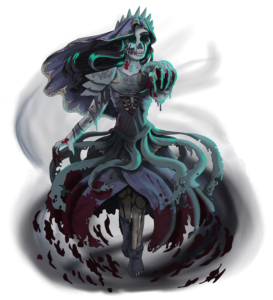
When players walk through the arch, read the following:
Within, the tree is hollow, a reminder that this was once a stone tower. But now bark, roots, and branches grow along its entire length, crisscrossing and covering everything. A fetid stench of decay and tree sap fills your lungs. On the floor opposite you is a massive marble sarcophagus, its lid broken. A gaunt humanoid woman floats beside it, toes hovering a few inches above the ground. Inky hair frames her grim translucent face. A crooning voice speaks in your head, sending a shiver running through you. “You are not Anahksi. Who are you?”
Queen Wrot’idauth communicates telepathically, as her language has been lost to time. She is vain and vicious, and will attack at the slightest provocation, but these new people offer a potential opportunity, and she is curious to learn if she can use them. The Antimagic Field has prevented her from crossing the bridge and defeating Vigilant-Warden, and so long as it lives, she cannot leave here.
She admits to wielding powerful magic and having warred against the Anahksi, but insists that the Anahksi massacred her people and unjustly imprisoned her. She tries to convince players to help her defeat Vigilant-Warden, saying that if it is destroyed, both she and the characters will finally be free. This is half-true. While the Anahksi did eventually conquer the Naodh-Meer, Queen Wrot’idauth had initially attempted to conquer them, which prompted the war and led to her confinement.
If she convinces the players to attack Vigilant-Warden, she will join them. If the characters fight her, she will not surrender and abandons all attempts to communicate.
Anyone trying to fly or climb up the tree’s interior can ascend 80 feet before branches block their way.
Resolution:
Killing either Wrot’idauth or Vigilant-Warden will free the players. In either case, when they kill their opponent, whatever structure the players are in will begin shaking, there will be a flash of bright warm light, and then they will find that the structure has been magically transported outside the pocket dimension and right next to the original building where they sought shelter, just as the dawn peaks over the hills. The rain has stopped, leaving behind the scent of wet grass in the crisp morning air.
Other rooms and elements from the dungeon dot the landscape.
If Queen Wrot’idauth is slain, Vigilant-Warden looks fondly at the players and offers a final word of thanks before crumbling into rubble, having fulfilled its purpose.
If Vigilant-Warden is killed, Wrot’idauth revels in her freedom, vowing to avenge herself upon the world. Now returned to her full power, she causes five massive black trees to sprout out of the earth, then teleports away.
Kassios and any other surviving members of the caravan greet the adventurers, grateful for their return, and very ready to leave this place and continue their journey.
